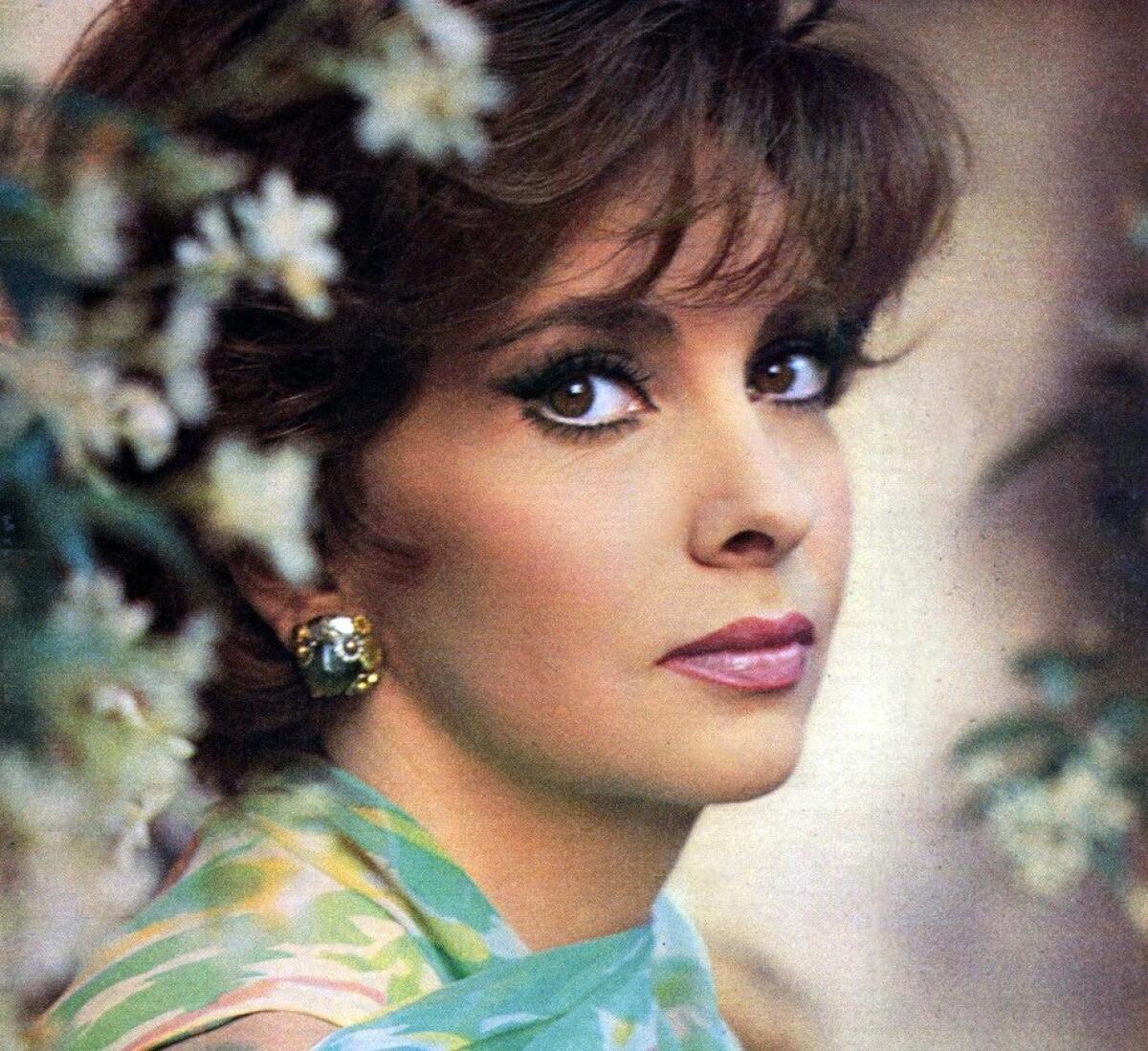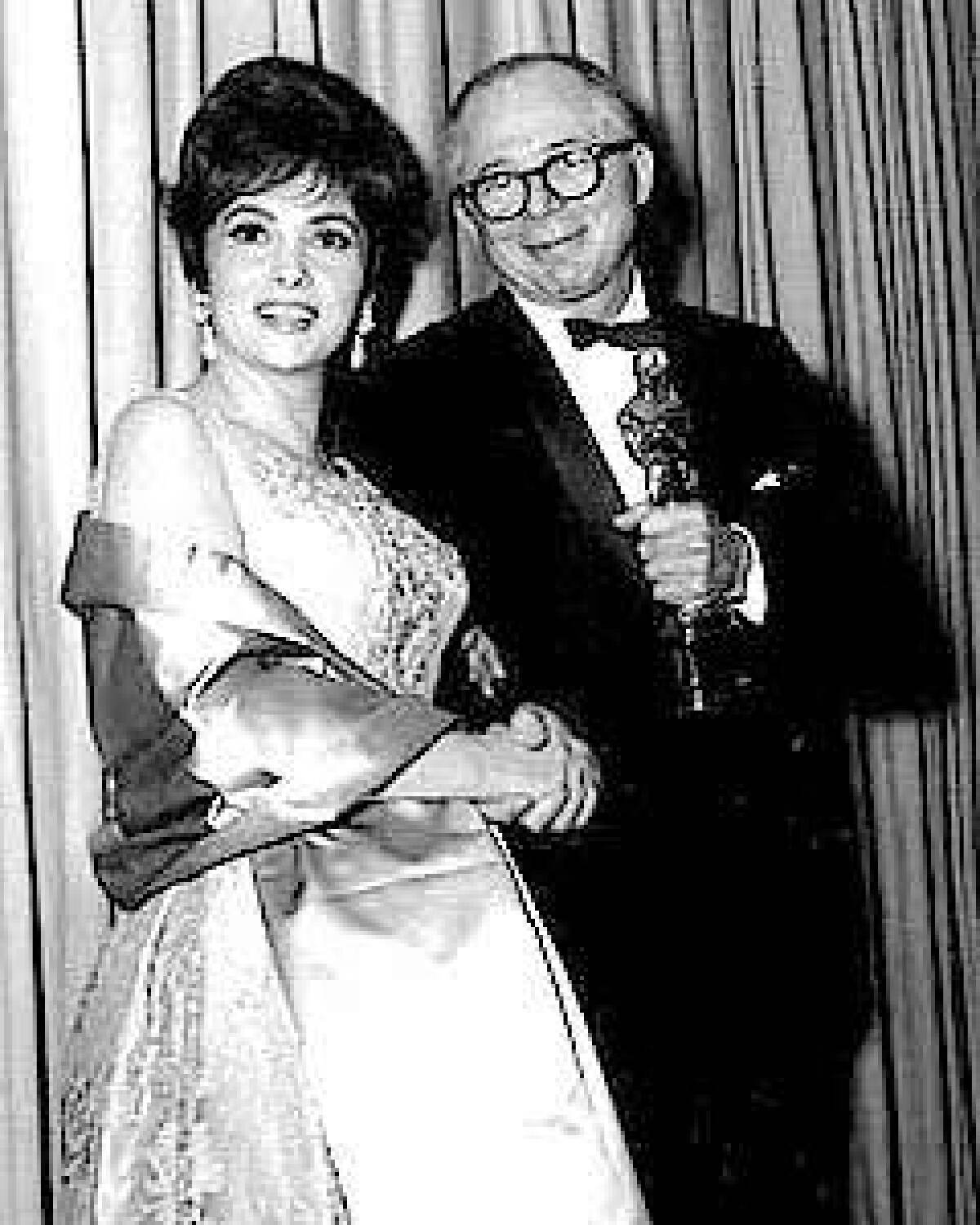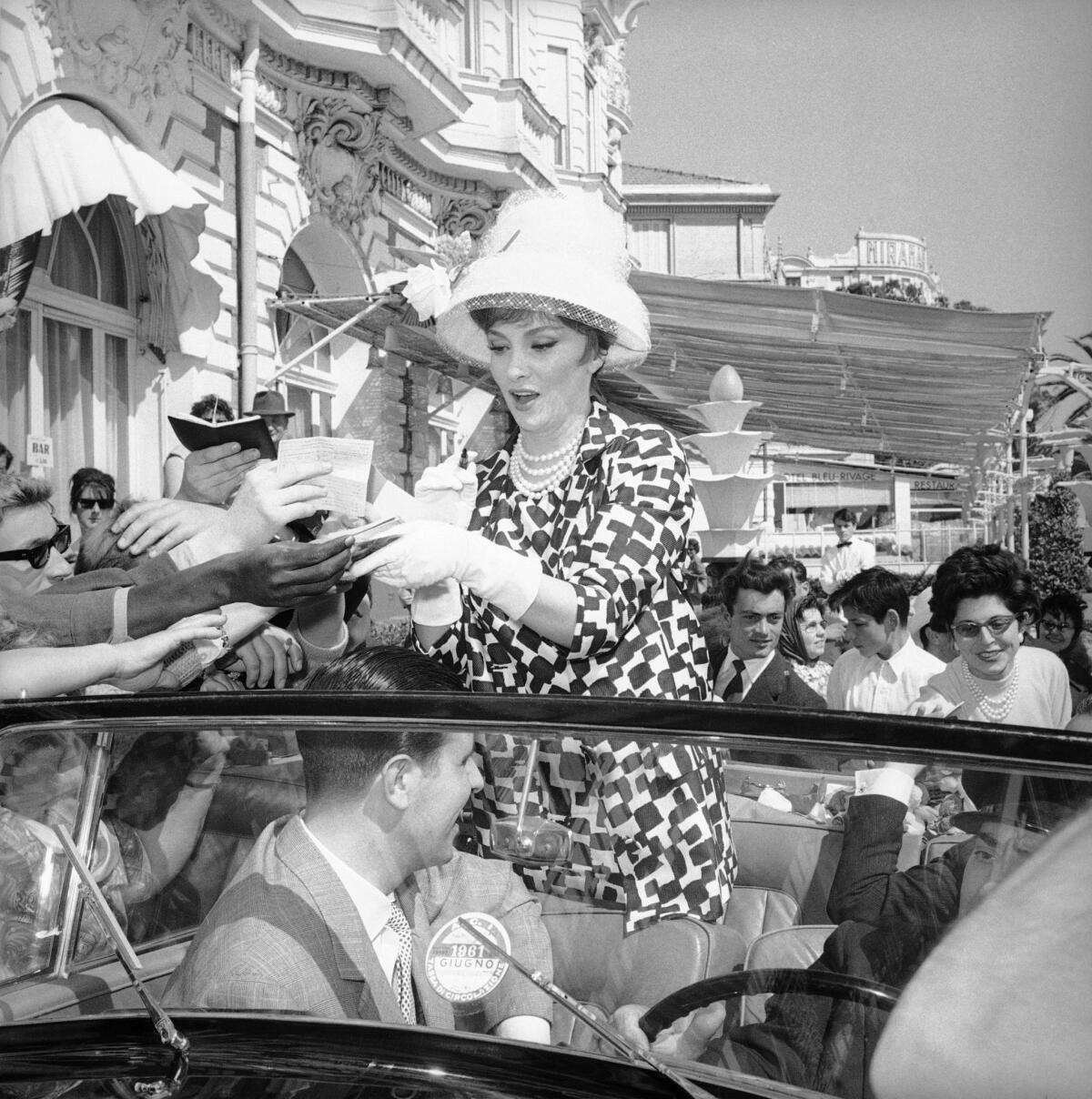Gina Lollobrigida, film star who conquered Italy, Hollywood and the world, dies at 95

- Share via
There she is, waving from the backseat of a convertible on the eve of the Cannes Film Festival. And here she is again, stepping to the tarmac from a jet in Paris, her scarf billowing perfectly in the evening breeze. And again, cloaked in emerald — dress and rings, both — in her villa outside Rome.
An actor, yes, but somehow Gina Lollobrigida was always more than just that.
As Italy was pulling itself from the rubble of World War II and the grinding oppression of fascism, Lollobrigida emerged as the face of la dolce vita, a siren beckoning Romans to once again indulge, celebrate and embrace.
“She represented something iconic, far more important than the actual talent she often displayed in her work as an actress,” wrote author Peter Bondanella in his book “Italian Cinema.”
Never out of the headlines for long and with a life captured in film and an endless burst of celebrity photographs — squeezed up next to Mick Jagger, Andy Warhol or David Bowie — Lollobrigida remained planted firmly in public view until her death Monday.
Forever beloved in her homeland, Lollobrigida died in Rome, the Italian news agency Lapresse said, quoting Tuscany Gov. Eugenio Giani. Lollobrigida was an honorary citizen of a Tuscan town.
Her agent, Paola Comin, also confirmed her death but did not give details, the Associated Press reported.
Lollobrigida had surgery in September for a broken thigh bone after a fall. She returned home and said she had quickly resumed walking.

Lollobrigida’s rise to stardom was rapid. She made movies in Europe and the U.S., signed a long-term Hollywood contract with Howard Hughes, starred alongside Yul Brynner, Frank Sinatra and Rock Hudson, kept company with Salvador Dali, Fidel Castro and pioneering heart surgeon Christiaan Barnard, and had a running drama-fest with fellow countrywoman Sophia Loren, a rivalry so fierce one wondered whether there was enough oxygen in Italy for the two of them.
“I am fire. I’m a volcano. All the things I do, I do with passion, fire and strength,” she said in a 1994 interview with The Times. “That’s me.”
Born in Subiaco, Italy, in 1927 (though she sometimes claimed it was 1928), Lollobrigida was the second of four daughters of Giovanni and Giuseppina Lollobrigida. When Allied air attacks destroyed their home in the early days of World War II, the family fled to the urban core of Rome.
Lollobrigida said her childhood memories were of hunger, hardship and upheaval.
“I know what it is to be hungry. I know what it is to lose your home. I remember when I had fear,” she told the Associated Press in 1994. “I know what it is to grow up never having a toy.”
She was studying sculpture at the Academy of Fine Arts in Rome when a talent agent spotted her and offered her a modeling and acting contract. When she was summoned to the Cinecitta studios, the hub of Italian cinema, she was offered 1,000 lire to sign.
“I told them my asking price was 1 million lire, thinking that would put a stop to the whole thing,” Lollobrigida told Vanity Fair in 2015. “But they said yes!”
Lollobrigida was cast in several movies filmed in Italy, including some for which she received no credit, before filming “Alina,” a melodrama in which Lollobrigida uses her beauty as her chief weapon in a dangerous smuggling operation. Among others, it caught the attention of Hughes, the eccentric businessman, aviator and maverick film tycoon.
Hughes quickly invited Lollobrigida to Hollywood for a screen test. Though she asked for two plane tickets so that her husband could accompany her, when her travel packet arrived in Rome, there was only one ticket.
Her husband, a physician named Milko Skofic, was less than pleased, but ultimately relented. “He said, ‘Go. I don’t want you to say one day that I didn’t let you have a career.’ So I went alone.”
Hughes parked the 24-year-old in a suite at the Town House Hotel, then a luxurious brick and terracotta retreat on Wilshire Boulevard. She was handed scripts and had sessions with a voice coach and an English instructor.
The two would go out to dinner, often at lesser diners so Hughes could avoid the media he so feared. Several times, she said, they ate in the car.

“I knew very little English then,” she told Vanity Fair. “Howard Hughes taught me the swear words.”
After 2½ months of fending off his advances and tolerating his erratic behavior, Lollobrigida said she signed a seven-year contract just so that she could go home. The pact made it difficult and hugely expensive for any American movie studio — other than Hughes’ RKO Pictures — to hire Lollobrigida.
She never made a single movie for Hughes and said she was content to wait out the contract in Europe, where there was no shortage of work.
Lollobrigida quickly became a star in Europe, appearing in nearly a dozen movies before her role in “Bread, Love and Dreams” earned her a BAFTA award for best foreign actress. It is regarded by some critics as her best, most natural performance.
“I succeeded in spite of Howard Hughes,” she said in a 1999 interview with the Age, an Australian newspaper.
In 1953, she returned to Hollywood and was paired with Humphrey Bogart in “Beat the Devil,” an adventure/comedy directed by John Huston and written by Truman Capote on a day-by-day basis during filming in Italy. It marked Lollobrigida’s first English-speaking film and — as would become her fate — called for her to play the role of a seductress. Though the film helped introduce Lollobrigida to America, it was a box-office failure.
She fared better three years later when she was cast as the manipulative, scheming Lola in “Trapeze,” the story of a crippled acrobat who tries to coax greatness from his brash, easily distracted protégé, roles filled by Burt Lancaster and Tony Curtis, respectively. The film, shot in Paris, was a financial success.
Lollobrigida went on to team up with Yul Brynner in “Solomon and Sheba,” a sexed-up Bible story, and with Rock Hudson in “Come September,” a 1961 romantic comedy about a married man and his mistress who discover that the villa where they meet up every year has been turned into a youth hostel. Sandra Dee and Bobby Darin are among the young tourists staying at the hostel. Despite a pancake-thin plot, the film did well.
And so the ’60s went — romantic comedy after romantic comedy matching Lollobrigida with stars like Ernest Borgnine, Frank Sinatra, Sean Connery, Peter Lawford and Bob Hope. If the films were sometimes forgettable — and Lollobrigida later admitted many were — they only seemed to burnish her star power. One might not be able to name a single one of her films, but everyone knew La Lolla.
As the Hollywood movie offers slowed, Lollobrigida returned to Italian cinema, though she did pick up a role in 1984 on the prime-time soap opera “Falcon Crest” and made an obligatory appearance on “The Love Boat.”
For all of her courtships and friendships and all the tabloid fodder that drifted in her wake, the person who became known as “the most beautiful woman in the world” was married just once, a union that ended in 1971. Or so she rigorously maintained.

But a man more than three decades her junior said the two were quietly married in Barcelona, Spain, in 2010 and that a surrogate stood in for Lollobrigida because she was worried the ceremony might turn into a media spectacle.
The man, Javier Rigau y Rafols, claimed Lollobrigida signed the marriage documents and that witnesses could verify the union. Photos of the two together had circulated for years.
She denied the marriage, however, and dismissed the license and other paperwork as a “horrific and vulgar fraud.” She filed suit in Italy and Spain and vowed to launch “an international investigation.” The truth, wherever it might be found, was quickly enveloped in legal disputes that were ongoing at the time of her death.
Men seemed to flow through Lollobrigida’s life like a fast-moving stream. They pursued her, and — she insisted — she kept them all at bay.
“It would be good for me as a human being to have a man that can advise me,” she told the New York Times in 1995. “But I can’t have everything. I have many interests, and maybe that’s enough.”
One of her interests was jewelry, which she collected as if she were a museum curator. She toured diamond mines in Africa and came home with a handful of gems. She bought gold bracelets encrusted with a galaxy of rubies, sapphires and emeralds. She went to India to shop for necklaces. And she openly wondered whether her pursuit of such opulence was the flip side to a deprived childhood. Eventually, she sold much of her collection and donated the proceeds to stem cell research.
She dabbled in sculpture and pursued a second career as a photographer, producing five books of photos. In 1973, she flew to Cuba — armed, she said, with eight cameras, 200 rolls of film and 10 pairs of blue jeans — and landed an interview with Fidel Castro, which was published in the Italian magazine Gente and billed as an exclusive.
“I was sunbathing nude in the garden of the residence when a man appeared and announced the presence of Fidel. He smiled at me, pretending not to notice my scanty clothing,” she wrote. “He shook hands with me, welcoming me to Cuba.”
In 1999, Lollobrigida ran for a seat on the European Parliament, admitting she had little interest in politics and only mounted a campaign because she’d been invited to do so. She shrugged off the whole thing when voters cast their ballots for more serious candidates. In 2022, she announced that she would run for a Senate seat, citing the political upheaval in Italy, but she lost her bid for office.
During her career, she won more than a dozen awards. She was nominated three times for a Golden Globe, winning one in 1961. In 1985 she was nominated to the Ordre des Arts et des Lettres, normally reserved for French citizens who have made significant contributions to the arts. French President Francois Mitterrand awarded her the Legion d’honneur for her accomplishments, and the National Italian American Foundation gave her a lifetime achievement award in 2008.
When she turned 90, the city of Rome turned out to celebrate in the historic Piazza di Spagna, and Lollobrigida unveiled a sculpture that had been commissioned in her honor. For decades she had lived in a villa near the ancient Appian Way (not to mention a ranch in Sicily and a house in Monte Carlo) and those in Rome saw her as a lifelong ambassador for all that was good and glorious in Italy.
“It’s just 30 plus 30 plus 30,” she told reporters when asked about her longevity.
And then, La Lolla being La Lolla, she reignited her feud with Loren.
“I was never looking for a rivalry with anyone,” she said. “But, again, I was always No. 1.”
Lollobrigida is survived by a son, Milko Skofic Jr.
More to Read
The biggest entertainment stories
Get our big stories about Hollywood, film, television, music, arts, culture and more right in your inbox as soon as they publish.
You may occasionally receive promotional content from the Los Angeles Times.











